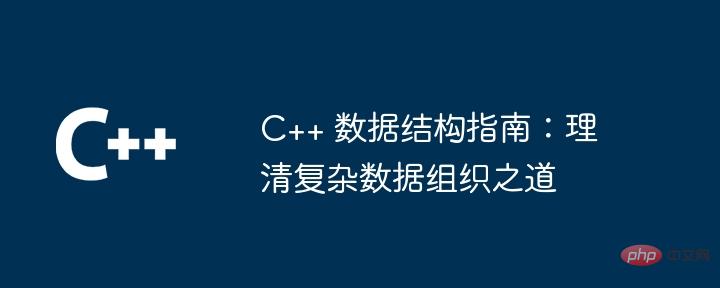
Answer: C++ data structures are the building blocks for organizing and managing data, optimizing retrieval and processing. Common structures: Array: ordered collection, vector access by index: dynamic array, fast insertion and deletion Linked list: flexible insertion and deletion Stack: LIFO principle queue: FIFO principle tree: hierarchical structure Hash table: fast key value lookup Application: Data storage, algorithm design, graphics processing, artificial intelligence, etc. Practical case: Using student information management application, involving data structures of vectors, sorting algorithms and hash tables.

C++ Data Structure Guide: Understanding how to organize complex data
Data structure is the basis for organizing, storing and managing data Building blocks play a vital role in C++ development. They provide structure to complex data, optimizing data retrieval and processing.
Common C++ data structures
Some of the most common C++ data structures include:
Applications of Data Structures
Data structures find application in a wide range of applications, such as:
Practical Case
Consider an application that stores student information. We can use data structures like:
// 学生对象
struct Student {
string name;
int age;
float gpa;
};
// 学生列表(使用向量)
vector<Student> students;
// 按年龄对学生进行排序(使用算法)
sort(students.begin(), students.end(), [](const Student& a, const Student& b) { return a.age < b.age; });
// 查找具有最高 GPA 的学生(使用哈希表)
unordered_map<string, Student> nameToStudent;
for (const auto& student : students) {
nameToStudent[student.name] = student;
}
auto bestStudentIt = max_element(nameToStudent.begin(), nameToStudent.end(), [](const auto& a, const auto& b) { return a.second.gpa > b.second.gpa; });Conclusion
Being familiar with data structures in C++ is crucial to building efficient and maintainable applications. By understanding the different types and their applications, you can choose the appropriate structure to meet your data organization needs.
The above is the detailed content of C++ Data Structure Guide: Untangling Complex Data Organization. For more information, please follow other related articles on the PHP Chinese website!
 Usage of treenode
Usage of treenode
 What are the differences between c++ and c language
What are the differences between c++ and c language
 Recommended learning order for c++ and python
Recommended learning order for c++ and python
 Cost-effectiveness analysis of learning python and c++
Cost-effectiveness analysis of learning python and c++
 Is c language the same as c++?
Is c language the same as c++?
 Which is better to learn first, c language or c++?
Which is better to learn first, c language or c++?
 The difference and connection between c language and c++
The difference and connection between c language and c++
 C++ software Chinese change tutorial
C++ software Chinese change tutorial




